William Optics RedCat 61
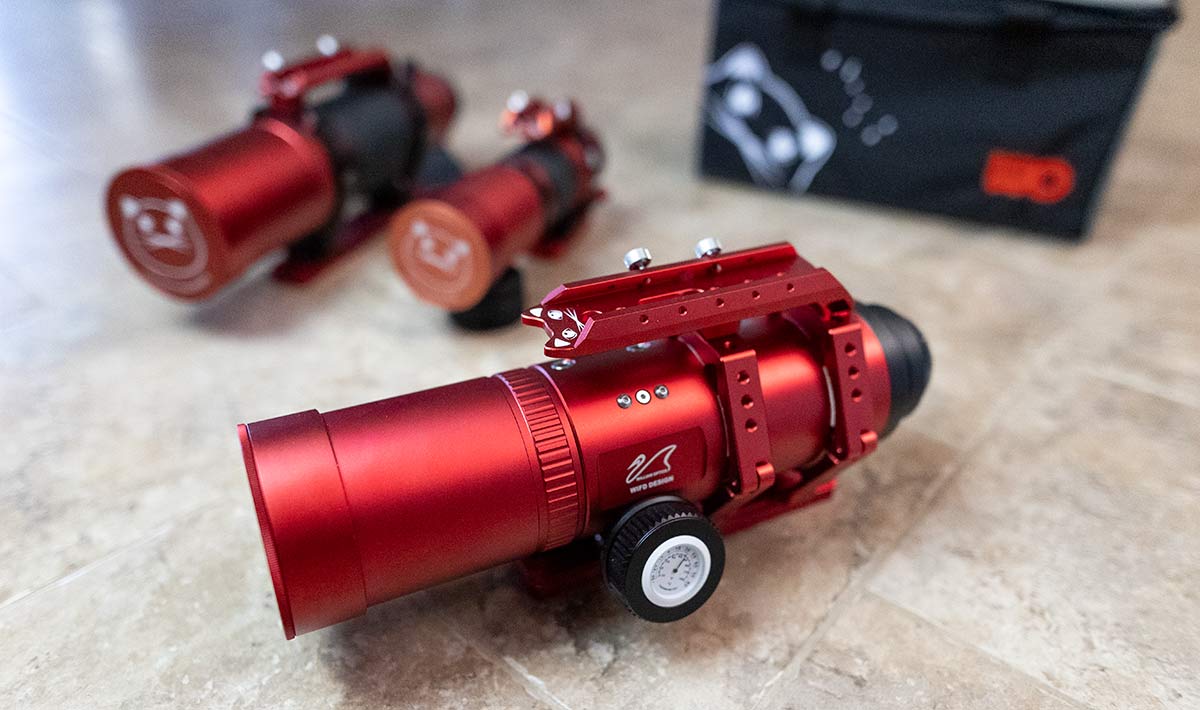
William Optics has introduced their third variation of the original RedCat Petzval Astrograph, the William Optics RedCat 61.
It’s small, it’s mighty, and it’s REDDER than ever. There’s also a huge change to this version of the RedCat when compared to the RedCat 51 and RedCat 71.
Like most reviews/first lights, I do my best to cover everything you need to know about this telescope before buying it while also capturing a beautiful deep-sky object to show you what it can do.
I have not been compensated for a positive review, nor does the company have any say in my review. It’s a ‘play with it and let us know what you think’ kind of deal.
The biggest draws of the little RedCat 61 are its image quality, compact size, and robust WIFD focuser. However, these premium features come at a cost.
At the time of writing, the William Optics RedCat 61 is listed at a retail price of $1,600 USD. A premium price, for a premium astrograph.
For comparison, you could purchase a much larger William Optics ZenithStar 81 with a field flattener for 2/3 of the price ($1,100) of the smaller RedCat 61.
Are the Petzval optics and WIFD focuser worth the extra money? I’ll let you decide.
The William Optics RedCat 61 is Available at Agena Astro.
A close crop of the Lagoon Nebulae in Sagittarius. RedCat 61 + ZWO ASI2400MC Pro.
I have included the image details for this photo, along with an up-close look to better appreciate the optics of this telescope. You can also view the full-size image on my Flickr profile.
William Optics RedCat 61
The RedCat 61 has a focal length of 300mm and a focal ratio of F/4.9. This means it is best used for wide-field nebulae projects and only the biggest galaxies. The moon is also in play, but planets are just too small for this scope.
Like the RedCats before it, the 61 uses FPL-53 glass in a Petzval lens design. This is a quadruplet lens design that is known for its sharp optics.
You can attach your full-frame DSLR, mirrorless, or dedicated astronomy camera to the T-mount and enjoy a 46mm image circle.
In the past, when using a full-frame camera, I’ve had to crop about 5% of the frame away using the RedCat 51 and 71 telescopes (43mm ad 45mm image circles).
The RedCat 61 is a practical astrophotography telescope for those using a DSLR, Mirrorless Camera, or a Dedicated Astronomy Camera.
The scope weighs just 7.5 pounds, and you can realistically tack on another 3-4 pounds for camera gear. This places the RedCat 61 in the small equatorial mount category or even on a well-balanced star tracker setup like the Star Adventurer GTI.
The RedCat 61 mounted to a portable star tracker (Star Adventurer GTi).
New WIFD Internal Focuser
The biggest change to this Cat is one that I think will make people who may have ignored the first version take notice. The helical focuser is gone, and it now uses the patented WIFD internal focus design.
This means that you can now use a traditional autofocuser with this scope, like the popular ZWO EAF. The design is also said to better handle heavy imaging trains and larger cameras without the worry of sag or tilt.
The center focuser was designed for precise internal sliding of fixed optics to prevent image shift. You can view and confirm your focus distance using the numerical display via the small window on the side of the RedCat 61.
This design redistributes the overall weight of the telescope and can help you achieve a better balance of your astrophotography rig.
Diagram showing the new WIFD internal focus design on the RedCat 61.
The WIFD internal focuser design is also available on the latest GT 81 APO, and I think William realizes he has a winner with this one.
As I will mention a little further down this post, the position of the focuser knob is something you will need to get used to.
I found that it would run into the saddle of the ZWO AM5 mount when placed in certain positions. To fix this, an option is to simply turn the telescope upside down in the tube rings.
Related Post: William Optics Pleiades 68 Review
William Optics RedCat 61 Specifications
This telescope falls into the compact, apochromatic refractor category. It is small enough to mount to a portable star tracker, but an intermediate-level astrophotography mount such as the ZWO AM5 or Sky-Watcher EQ6-R Pro is recommended.
Let’s have a look at the core specs of this refractor telescope.
- Focal Length: 300mm
- Diameter: 61mm
- Aperture: f/4.9
- Image circle: 46mm FF
- Flattener: Petzval Flat Field
- Focuser: Internal Focus Design
- OTA Weight: 5.43lbs / 2.465kg
- Total Weight: 7.47lbs / 3.390kg
What’s Included in the Box?
In terms of overall presentation and attention to detail, all of the William Optics products are really slick. They always include a stitched, padded bag, warranty, and yes, sometimes even cat stickers.
Included with the RedCat 61 are the red tube rings, a cat series handlebar for attaching other accessories, and a dovetail bar. Like most other William Optics telescopes, a dew shield cover and built-in ‘star spikes’ Bahtinov mask are also included.
What Comes with the RedCat 61:
- Stitched and padded carry bag
- Tube Rings
- Cat Handlebar
- Dovetail bar
- Built-in dew shield
- Built-in Bahtinov mask
I am happy to see that the ‘cat saddle’ dovetail bar is included in the package. As this is primarily a deep-sky astrophotography telescope, adding a small guide scope and camera to the configuration is something you’ll want to do early on.
I recommend a lightweight 30mm guide scope like the ZWO 32mm Uniguide or a ZWO 30mm F/4 guide scope. These tiny little guide scopes do a great job and add very little weight to the overall setup.
As for pairing a camera to this telescope, a full-frame DLSR or mirrorless camera is a great choice. If you’re comfortable using a dedicated astronomy camera, a full-frame one-shot-color camera is an excellent fit.
The Set Up
As you can see, it’s RED overload here on the ZWO AM5 mount – some may say it’s even TOO red. I can also confirm that this telescope is a great fit for the equally portable Sky-Watcher Star Adventurer GTi.
The dovetail bar included with the RedCat 61 sits nicely in the mounting saddle on the AM5. However, you will need to ensure sure that the telescope is sitting far enough forward so that the focuser knob does not run into the mounting plate.
If you are used to refractor telescopes with a focuser at the back of the telescope, the centrally located WIFD focuser is something to be aware of.
My Astrophotography Setup featuring the RedCat 61.
- Telescope: William Optics RedCat 61
- Camera: ZWO ASI2600MM Pro
- Mount: ZWO AM5 Harmonic Drive Mount
- Guide Scope: William Optics Uniguide 32mm
- Guide Camera: ZWO ASI120MM Mini
- Camera Control: ZWO ASIAIR Plus
In terms of mounting, a GoTo mount in the 20-30 lb payload range is more than enough. I’m sure the AM5 will be a popular choice if you plan on traveling with the rig.
Sticking with the lightweight motif, you can see the tiny 32mm guide scope I’ve mounted to the cat saddle. You can pick up an ASI120MM Mini and a little guide scope like this for about $250 (all in).
I’m a big fan of ultra-portable setups like this, but make no mistake, a configuration like this is best for capturing WIDE field images. If you want to go deeper, you’ll need a longer focal length.
I used the ASIAIR Plus to run the camera, which is an ASI2600MM Pro with an electronic filter wheel in front. With this camera – I get an image scale of about 2.5 arc seconds per pixel. This may be a little crispy (i.e. pixely, boxy, stars) for some, but overall it’s pretty well matched.
I would suggest not obsessing over image scale because a lot of these ‘rules’ don’t mean a whole lot after you apply techniques like BlurXterminator afterward anyway.
Because of its compact size, I am looking forward to testing it out with my full-frame mirrorless camera (Canon EOS Ra) in the future as well.
The threaded M48 connection at the back of the scope couldn’t be easier, and with no additional flattener or reducer needed the correct backspacing at this connection is ready to go.
Astrophotography Results with the RedCat 61
To all the people that accuse me of shooting the same targets over and over again, I am happy to inform you that I went after something a little more obscure with this telescope.
Just north of the star Sadr, lies a collection of sinewy ribbons of hydrogen gas and a fascinating object known as the Propeller Nebula. After over a decade of shooting, I have never attempted to photograph this nebula before!
I shot this target using narrowband filters due to a bright, 82% illuminated Moon. The seeing conditions during this image were not great and I was shooting through high clouds for a while.
This is what a stack of images looks like in Ha, OIII, and SII with the RedCat 61. Everything looks as it should in terms of optics – but as I said, narrowband imaging doesn’t exactly scrutinize a scope.
If we combine the narrowband image stacks together into RGB channels, you get a little something like this.
The Propeller Nebula in Cygnus. 3 Hours Total Exposure.
Image Details:
- 15 x 4-minutes (H-Alpha)
- 15 x 4-minutes (SII)
- 15 x 4-minutes (OIII)
The images were registered and calibrated in DeepSkyStacker, and processed in Adobe Photoshop and PixInsight. For a better understanding of the way I process my astrophotography images, feel free to check out my premium image processing guide.
Broadband Image Test
In June 2023, I began collecting data in broadband color with the William Optics RedCat 61, using a full-frame one-shot-color camera (ZWO ASI2400MC Pro). The following image was taken without the use of any filters from a Bortle Scale class 2 site.
The telescope was mounted to a portable star tracker (Sky-Watcher Star Adventurer GTi) and the imaging session was controlled using the ZWO ASIAIR.
The Lagoon and Trifid Nebulae in Sagittarius using the RedCat 61 and a ZWO ASI2400MC Pro color camera.
Image Details:
- 67 x 2-minutes (no filter)
The images were stacked in DeepSkyStacker using calibration frames, and processed in Adobe Photoshop and PixInsight. This image is a much better sample of the superb optics of the RedCat 61.
To give you a better idea of how spectacular this image data really is, have a look at this 100% zoom on NGC 6559 next to the Lagoon Nebula. I think I am going to enjoy this ‘scope.
100% zoom on NGC 6559 in the same field of view.
Differences Between RedCats
Here is a table showing the differences between the three generations of RedCat telescopes.
| RedCat 51 | RedCat 61 | RedCat 71 | |
|---|---|---|---|
| Aperture | 51mm | 61mm | 71mm |
| Focal Length | 250mm | 300mm | 348mm |
| Focal Ratio | f/4.9 | f/4.9 | f/4.9 |
| Optical Design | Petzval Refractor | Petzval Refractor | Petzval Refractor |
| Weight (OTA with ring, dovetail and saddle) | 3.9 lbs / 1.76 kg | 7.47lbs / 3.390kg | 8.2lbs / 3.7kg |
| Tube Length (fully extended) | 291mm | 365mm | 435mm |
| Image Circle | 43mm | 46mm FF | 45mm |
| Focuser | Manual Helical focuser | WIFD (WO Internal Focus Design) | Helical Focuser with 2GT Gear Ring |
| Field of View | 4.88° x 3.25° (with APS-C camera) | 4.88° x 3.25° (with APS-C camera) | 4.88° x 3.25° (with APS-C camera) |
| Approximate Price (USD) | $865 | $1,598 | $1,698 |
Unlike when the original RedCat 51 came out in 2019, there are several telescope options to choose from at this focal length.
The complete RedCat family (51mm, 61mm, and 71mm).
With the introduction of the internal focuser, it seems like William is moving away from the ‘is it a telescope or a lens’ idea, and doubling down on the idea of an astrophotographic-specific Petzval APO refractor.
I personally experienced some slight issues with TILT on the previous Redcats, but to be fair, I didn’t really have the right tools or know-how to properly identify and adjust them. They did come with a tilt adjuster, but it was a hard thing to get just right.
I have a feeling that a big part of the new focuser design will address this issue. Based on my test images, it seems that tilt is no longer an issue, at least on the unit I demoed.
One thing to consider for those looking into the RedCat 51 or 61 is the overall size profile of the telescope. As you can see in the photo below, the RedCat 61 is much larger than the 51, which could be an issue when traveling with the RedCat on an airplane.
The profile of RedCat 61 is substantially larger than the RedCat 51, which makes it less travel-friendly.
Full-Frame Image Circle
I know that a lot of folks who used the original RedCat 51 were a little disappointed with the 43mm image circle. Although this is still very useable with a full-frame sensor, there was some vignetting in the corners of the image.
I am pleased to report that the larger 46mm image circle on the RedCat 61 makes a noticeable difference. I did not experience any noticeable vignetting with my full-frame ZWO ASI2400MC Pro color camera.
Also, the stars at the edges of the field looked great, right to the edge. Have a look at the star quality of my image of the Lagoon and Trifid Nebula region.
The star quality at the edges of my full-frame image sensor using the RedCat 61.
Installing an Autofocuser on the RedCat 61
One of the biggest benefits of the new WIFD internal focus design on the William Optics RedCat 61 is the ability to install a traditional aftermarket autofocuser on the telescope.
The ZWO EAF is a capable entry-level autofocuser that can be easily installed on the RedCat 61. The process of installing an electronic focuser to a refractor telescope involves removing the focuser knob of the telescope using an Allen key.
Once the electronic focuser is installed, you can remotely focus the telescope using an ASCOM-compatible astronomy software (such as N.I.N.A), or the popular ZWO ASIAIR Plus mobile app.
The ZWO EAF (electronic auto focuser).
I have not yet installed the ZWO EAF on my RedCat 61, but William created the following installation guide for reference.
The image used in this guide were taken while installing the ZWO EAF autofocuser on the William Optics GT 81 (WIFD), but the process is the same for the RedCat 61.
Final Thoughts
The William Optics RedCat 61 is a premium astrograph with high-end optics. There are no additional field flatteners or reducers needed for optimum performance.
It has a huge image circle and rotator, the types of things you have come to expect from the Cat series of telescopes.
The internal focuser was a good call, and you can now use a standard autofocuser. The WIFD design means you’re not extending the imaging train to reach focus, which is a nice change for those of us who are used to a long imaging train.
One issue I had with the RedCat 61, so far, was the size of the huge focuser knob, and its central position on the telescope. It runs into the mounting plate on the AM5.
To fix this, I had to move the scope up a bit, but at first, I couldn’t understand why the focuser wouldn’t move. Not technically an issue – more of something to keep in mind
The other thing to consider is, of course, the cost. It is currently $1600 USD, and for a 61mm telescope, that’s pretty steep. However, you save the cost of a corrector and it comes with a bag, dovetail to mount a guide scope, and Bahtinov mask.
I think there is a huge market for this telescope. I think it has to potential to outsell the original RedCat 51, which would really be something.
There’s definitely a goldy-locks vibe to the 61. The 51 was impressive and small, the 71 had more reach but kept the helical focuser but this one gets just about everything right.
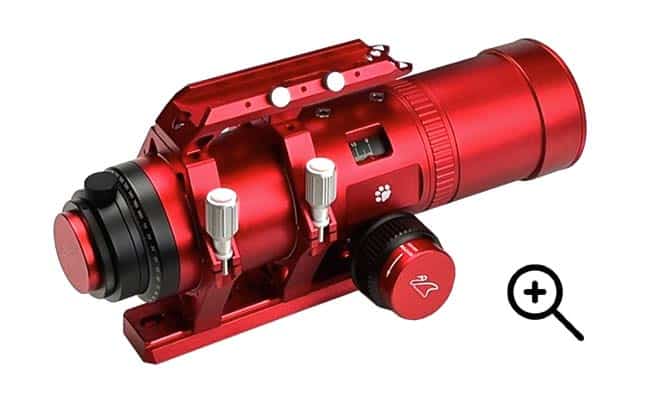

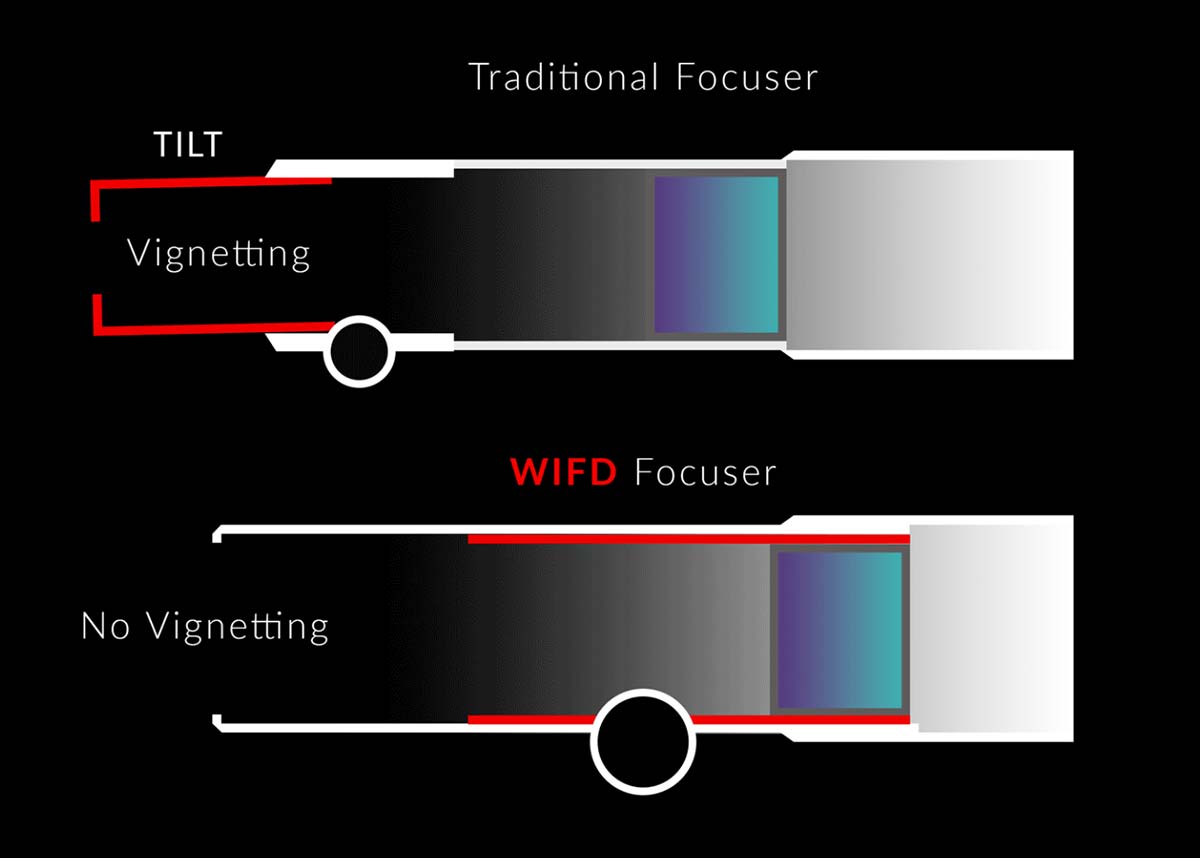
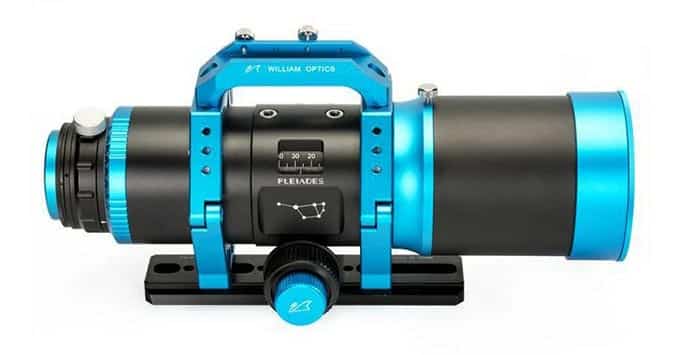
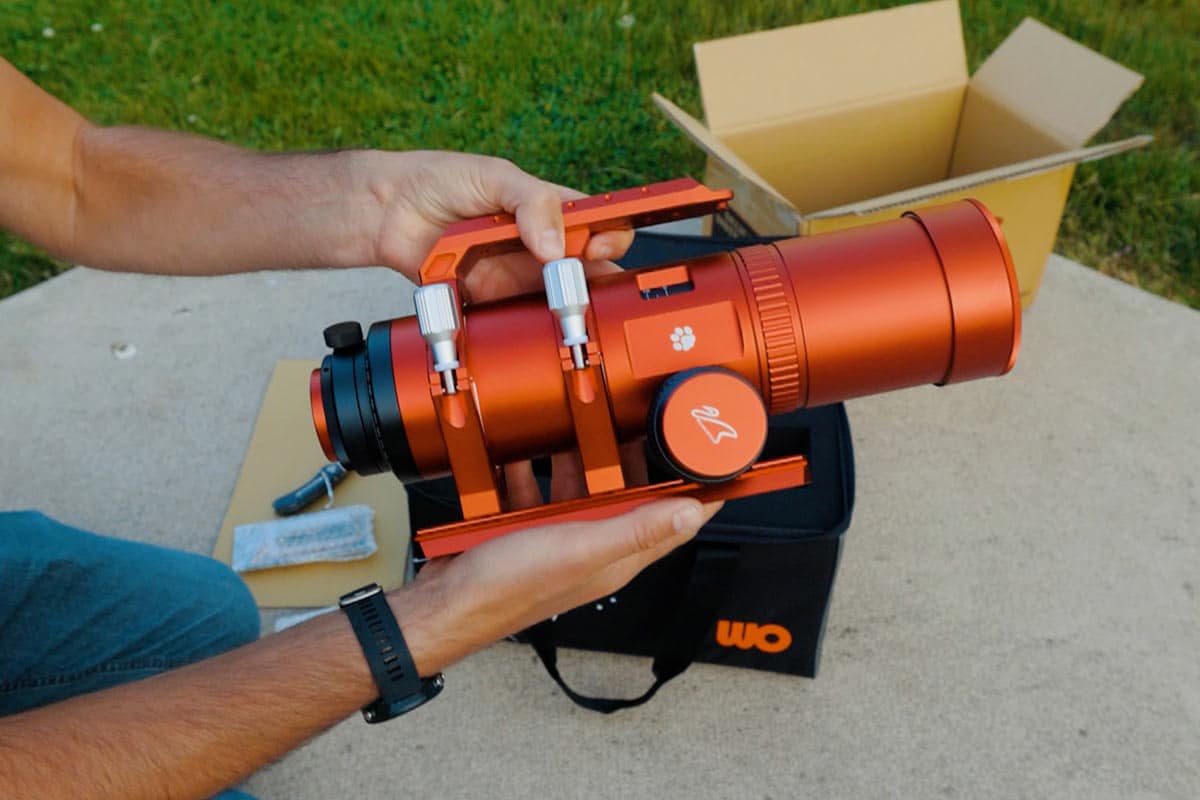


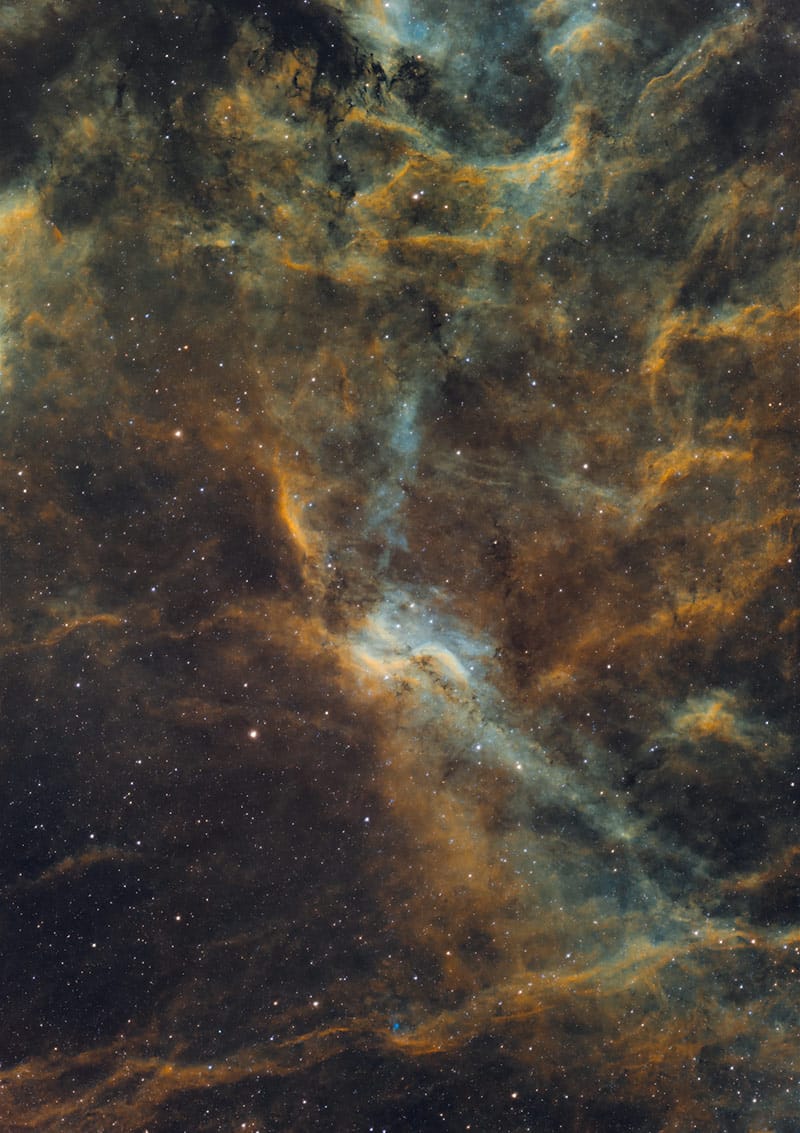
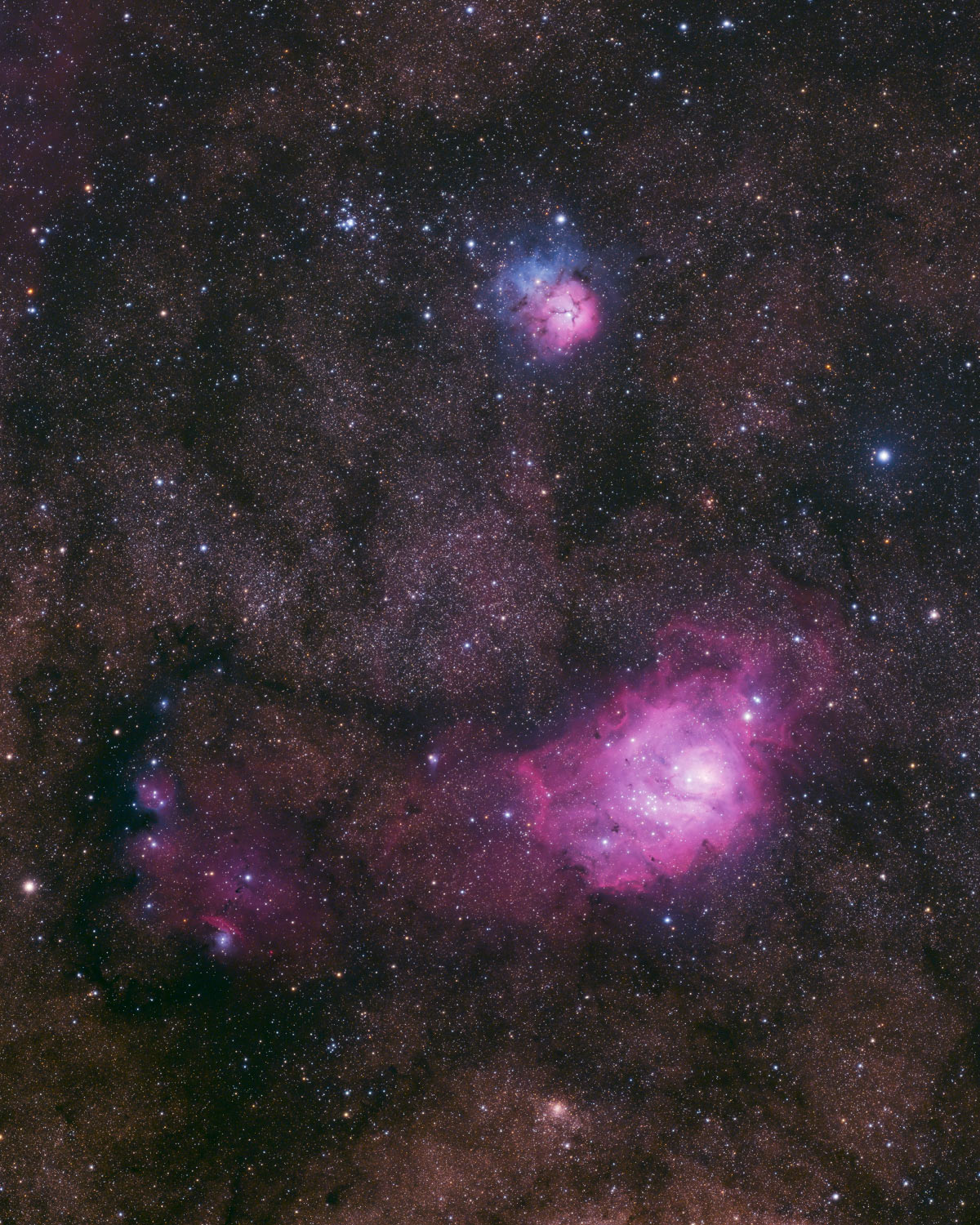
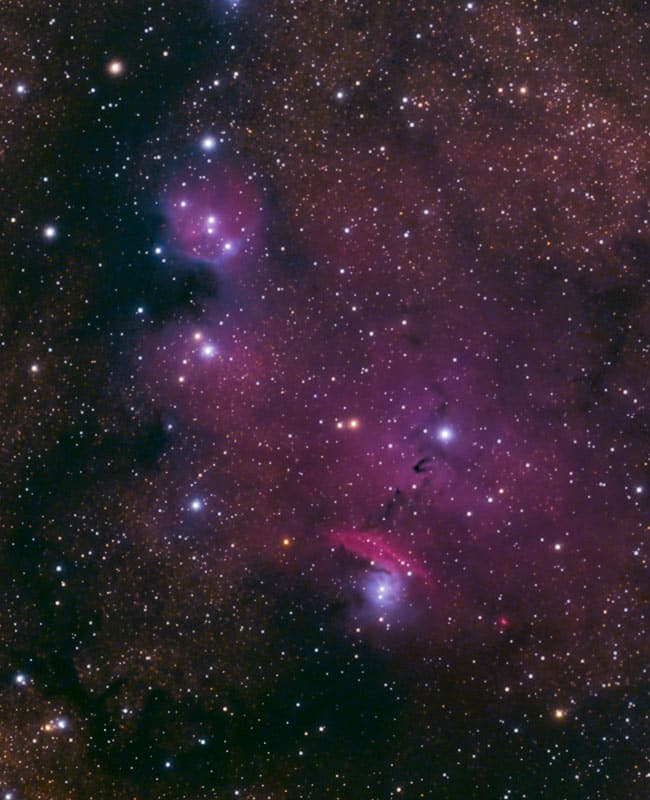

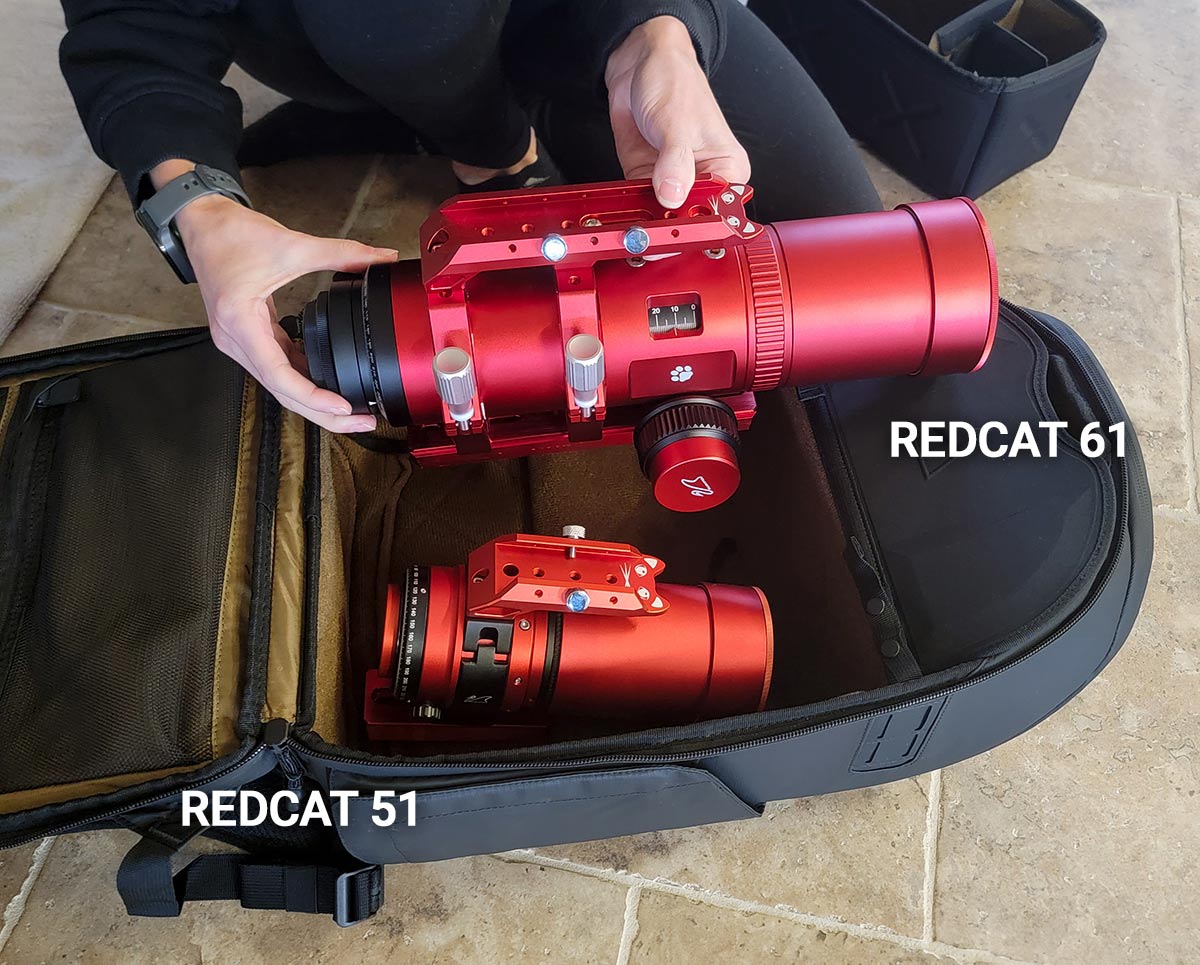

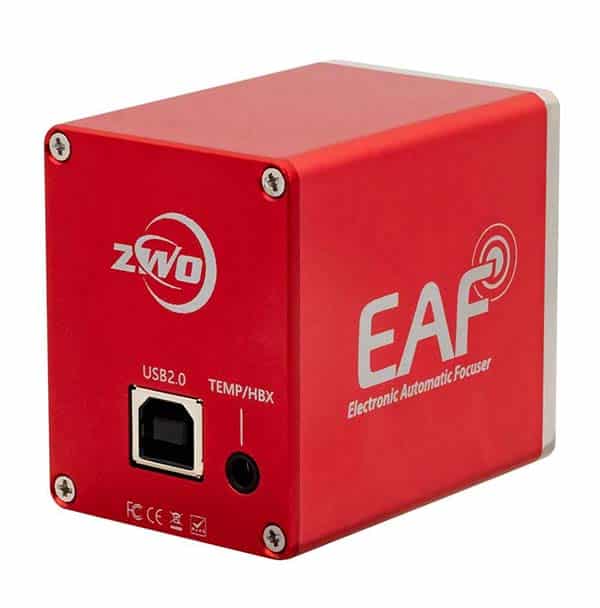

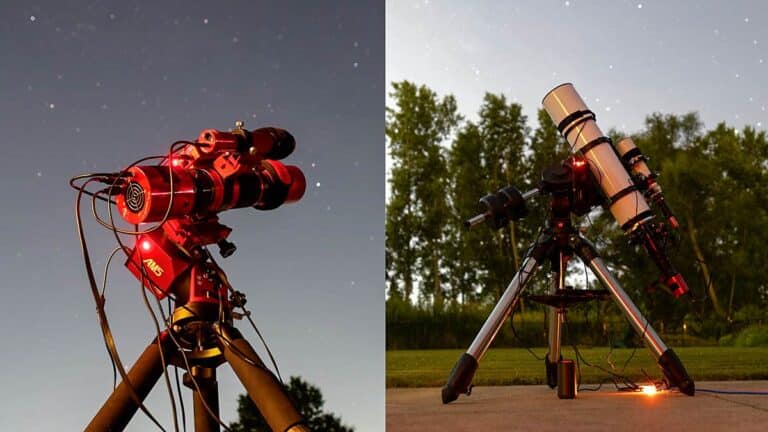
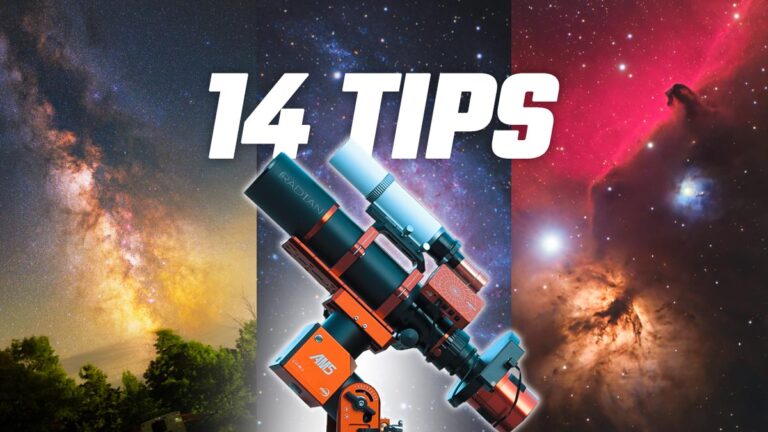
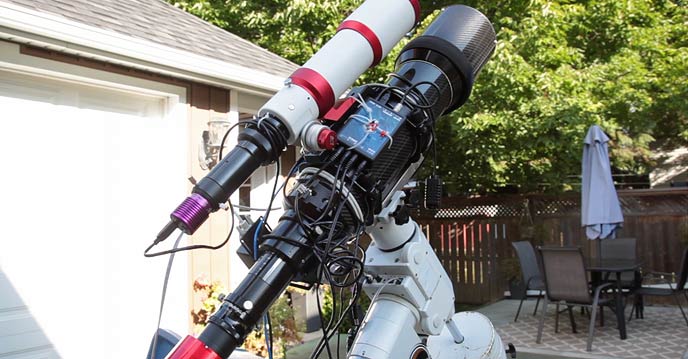
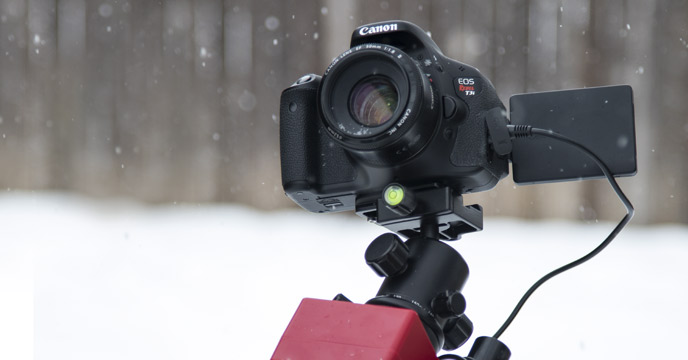

Can you do a video or an article about the EAF install on the RedCat 61. I bought the whole thing and I am a bit nervous.
Hi Trevor,
Great review, as always !
Do you think this scope can be handle by the star adventurer 2i ? Or is it better to stick to a redcat 51 with it ?
Regards !
Why not get the bigger version?
Hi Trevor – great review and thanks! I just pulled the trigger on a Redcat 61 along with the 2600mm. Can you recommend filters for the 2600mm?
Thanks,
-Matt